A Monumental Travesty
This article first appeared in the June 2022 issue of Adventure Cyclist magazine.
A smiling bronze cherub stands on a pedestal clutching an ancient bicycle on a street corner in Bar-le-Duc, a sleepy town in northeastern France. The imposing monument was inaugurated with great fanfare in the midst of the bicycle boom on September 30, 1894. The inscription below reads: “To Pierre and Ernest Michaux, the original inventors and developers of the pedal velocipede [a.k.a. bicycle]. The grateful cyclists of France.”
One has to read a blurb posted on a nearby stanchion to learn that the father-and-son team was actually based in Paris — and not in Pierre’s hometown of Bar-le-Duc — in 1861, the year that they allegedly invented the bicycle. For although the refurbished fountain has no fewer than six different years carved into it, no year of invention is cited. That was probably no oversight.
When the call for a memorial first sounded in 1890, the original historical premise was a longstanding, but unsubstantiated, claim in French cycling lore that the Parisian blacksmith Pierre Michaux alone had invented the bicycle in 1855, after adding pedals to a broken draisine. But three years later, in the midst of the campaign, his eldest surviving son Henry suddenly recalled that he had witnessed a collaborative invention in March of 1861 (at the tender age of six).
For a full century, Henry’s dubious account largely passed as accepted history. That is, until I challenged it during the memorial’s centennial year at the fifth annual International Cycling History Conference in Cambridge, England (this year’s in Indianapolis will be the 31st, the last two years having been canceled due to the COVID pandemic).
Recently, I revisited the Michaux memorial campaign, using digital tools that did not exist a generation ago. I discovered that that convoluted affair was even more flawed than I had originally deduced. Indeed, one key new discovery strongly suggests that the humble workman who sparked the bicycle revolution was actually the original bicycle patentee Pierre Lallement, who was buried in a pauper’s grave in Boston’s Mount Benedict Cemetery in August of 1891. But before we get to that, let’s recap how the memorial and its associated claims came about in the first place.
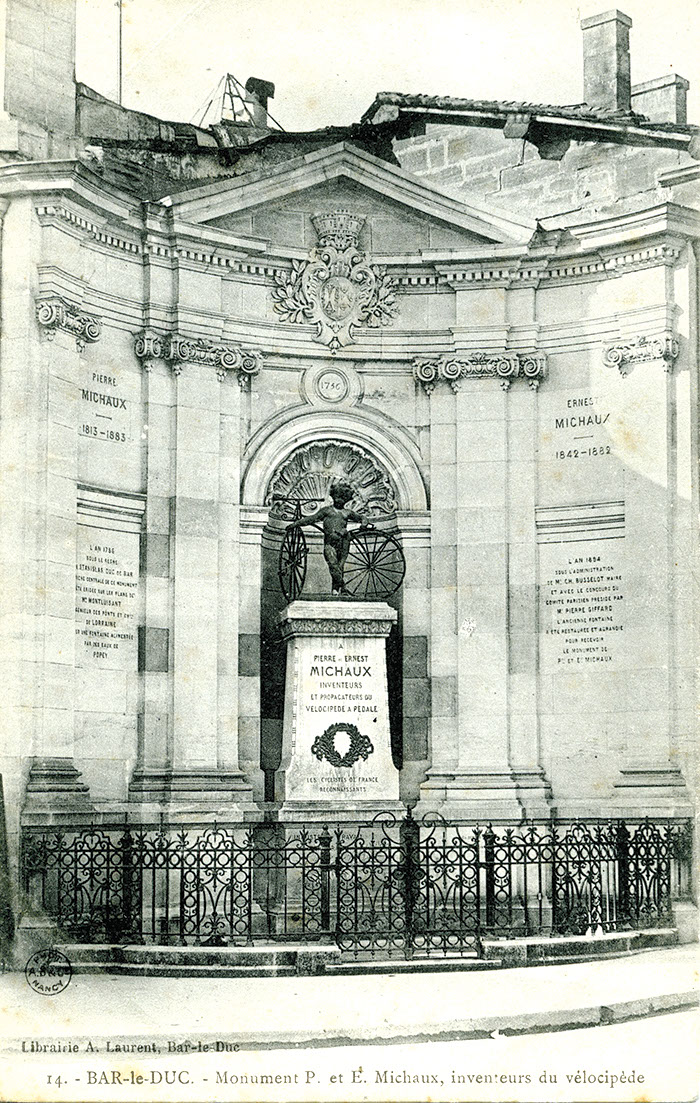
The Rover-style, or “modern,” bicycle was developed in England in the late 1880s. It made a modest appearance at the 1889 Paris International Exhibition (the one that produced the Eiffel Tower), before launching a full-scale invasion of France the following year.
In France, the new vehicle became known as the “bicyclette” (small bicycle), an attractively French-sounding word coined by a clever British exporter. To French ears, the term evoked fond memories of the original “boneshaker” bicycle, introduced in their country in 1867. For about four years, the pioneer French industry, headed by the Michaux company, would lead the world in bicycle production and development.
That is, until the disastrous Franco-Prussian war erupted in mid-1870 and brought down the cycling industry as well as the Second Empire. For the next two decades, thanks in large part to its mastery of high-wheel production, the British industry ruled the burgeoning cycling world, even as its American counterpart emerged as a significant rival.
As the French cycle industry began to reclaim some of its former glory, a domestic demand arose for a memorial to celebrate the true origins of the bicycle — and to correct the popular misconception that it was a British or even German invention. In the summer of 1890, a French cycling magazine, La Revue du Sport Vélocipédique, called for a memorial to Pierre Michaux, based on the 1855 claim.
Not surprisingly, given the lack of supporting evidence, the initial Michaux memorial appeal fell flat. Interest picked up the following spring (1891), however, after some four hundred German cyclists gathered in Karlsruhe to ceremoniously rebury the remains of Karl von Drais, the inventor of the draisine, who had died in poverty 40 years earlier. “When will we have a statue of Michaux, that ingenious carriage builder who took the draisine such a giant step forward?” huffed Richard Lesclide, who had recently revived Le Vélocipède Illustré, the flagship cycling journal he had founded in 1869.
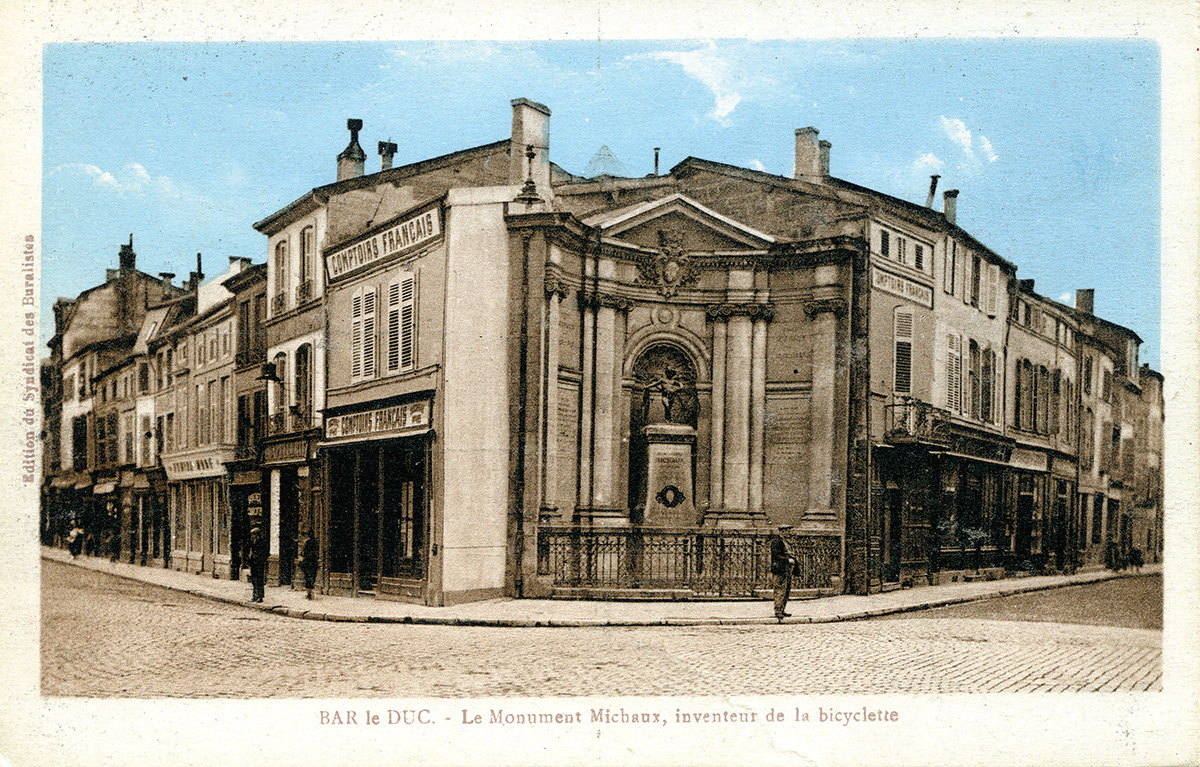
Also in 1891, the widespread diffusion of practical inflatable tires, which the French firm Michelin helped to develop, greatly improved the performance of the bicyclette. Two great road races, one from Bordeaux to Paris, the other Paris to Brest and back, enthralled the public. And two bestsellers, Pierre Giffard’s La Reine Bicyclette (The Queen Bicycle) and Louis Baudry de Saunier’s Histoire Générale de la Vélocipédie (A General History of Cycling) touted the virtues of cycling.
By the 1892 season, in the midst of a full-blown cycling rage, the French cycling establishment increasingly viewed the erection of a memorial to a French bicycle inventor as a patriotic duty. That June, Le Vélocipède Illustré reiterated its call for a Michaux memorial.
As it happened, that issue fell into the hands of Henry Michaux, who was then living in London. He promptly wrote Juana Lesclide, who had just taken over the reins of the magazine following the death of her husband Richard, to express his condolences and to thank her for supporting a Michaux memorial. He stressed his willingness to participate in such a noble venture.
But before the 26-year-old widow could claim ownership of the project, La Revue du Sport Vélocipédique announced that it was finally starting its fund drive for a Michaux memorial. Shortly thereafter, however, just as contributions started to flow in, the magazine received a cease-and-desist letter from Henry who affirmed that he had authorized Le Vélocipède Illustré exclusively to pursue the memorial project. The stunned editor reluctantly complied.
In the fall of 1892, Le Vélocipède Illustré, now fully in charge of the project, began to make a historical case for the memorial, relaying information provided by Henry. Although he initially glossed over the details of his father’s alleged invention, he asserted that Pierre had made and sold over 1,000 bicycles between 1861 and April 1867, when the Universal Exhibition opened. Henry claimed to have the original ledgers to back his figures, though he never actually produced them.
Henry’s point was nonetheless clear: his father was not only the bicycle inventor but also its primary developer, contradicting the widely held notion that the blacksmith had sat on the bicycle idea for years. Henry, who was making plans to relaunch the Michaux bicycle brand, thus opportunistically cast himself as the next generation of Michaux innovators and industrialists.
Henry soon moved to Paris to orchestrate the memorial project while he raised money for his new bicycle company. By early 1893, however, Juana had soured on the project. She had discovered that Henry was defrauding his investors (including a few she had steered his way) and that another Pierre (Lallement), held the original bicycle patent, granted in 1866 in New Haven, Connecticut (neither of Pierre Michaux’s two patents prior to 1868 involved the bicycle).

Rather than explain her newfound concerns, Juana simply stopped writing about a Michaux memorial. She only hinted at her motives for inaction in brief responses to reader inquiries, such as “The Michaux files lack essential elements,” and “It is better for the memorial project that we keep our silence.”
Albert Ricaudy, a 25-year-old cycling columnist for the Parisian daily L’Événement, grew impatient. In January 1893, he wrote, “And Michaux? … What’s going on with that? Is he or isn’t he the inventor of the velocipede with pedals? If ‘yes,’ why is the memorial project stalled? If ‘no,’ why hasn’t anyone proven positively the falsity [of the memorial’s premise]?”
After Juana refused to budge, Ricaudy took matters into his own hands. He found a sculptor willing to make a bust of Michaux for a bargain price, and he announced a fund drive. Le Vélo, a cycling daily headed by the cycling evangelist Pierre Giffard, promptly issued a warning, written by someone using the nom de plume D. Cooper: “Do you know why, dear colleague, you will have a great deal of trouble bringing this project to fruition? Because the origins of the velocipede lack clarity. Michaux? Of course. But who else besides him?”
Undaunted, Ricaudy secured the patronage of a syndicate of cycling journalists to which he belonged. On February 20, the group appointed a subcommittee to oversee the Michaux memorial project, including Ricaudy as treasurer. Giffard was named president, despite his paper’s misgivings about the project.
Although Giffard was a relative newcomer to the sport of cycling (he had taken up riding the bicyclette in 1890 at his doctor’s suggestion), he was widely equated with the sport itself. And as a contributor to Le Petit Journal, Paris’s largest circulating paper, he commanded a vast readership. His participation in the memorial project thus all but guaranteed its success. And, from his perspective, the campaign promised to generate ample publicity and “filler” material.
The committee also decreed that the bust of Michaux should be placed in Bar-le-Duc, and it authorized Ricaudy to enlist the support of the mayor, Charles Busselot. The very next day, Ricaudy took a train to Bar-le-Duc, where he was warmly greeted by Busselot and reporters from two local papers who enlightened the locals about Bar-le-Duc’s previously unknown “claim to fame.”
A few days later, the mayor himself came to Paris to attend the committee’s second weekly meeting. He returned with a personal letter signed by Henry Michaux, attesting that his father was the sole inventor of the bicycle (though he neglected to give the year).
But just as the memorial project appeared headed to a swift and successful outcome, the cycle historian Louis Baudry de Saunier published an incendiary article in La Revue des Sports, alleging that the true bicycle inventor was actually Ernest, Pierre’s eldest (and deceased) son, who transformed a broken draisine into a bicycle in 1855 as a teenager. Pierre Michaux, according to Baudry, had never even ridden a bicycle, nor had he approved of his son’s involvement with two-wheelers.
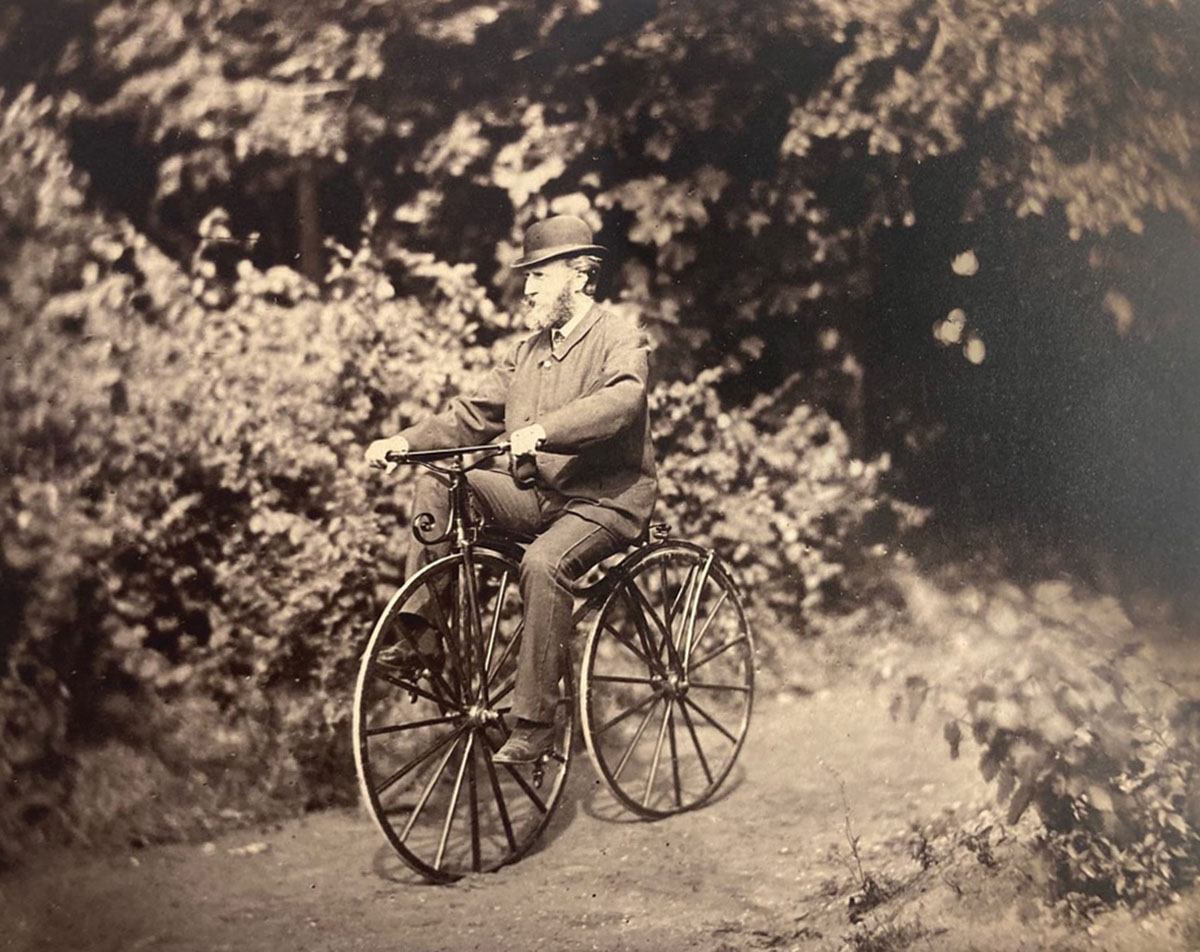
Baudry’s alarming allegations threatened to make the syndicate a national laughing stock. “The commemorative committee is in deep despair,” wrote one cycling columnist. “After going to such trouble to build a statue only to learn that its likeness had never invented anything. I look forward to hearing about what they decide to do at their next meeting.”
Indeed, the committee was in a bind. It could not simply replace Pierre with Ernest in the role of inventor, since that shift would remove any rationale for placing the monument in Bar-le-Duc, Ernest having been born in Brittany.
At this point Giffard effectively took over the troubled project. A day after Baudry’s article appeared, the editor defensively pointed out that Baudry himself had credited Pierre Michaux with the bicycle invention in Histoire Générale. However, to avoid any further debate, Giffard proposed that the monument should recognize both Pierre and Ernest as co-inventors.
Baudry acknowledged that he had initially credited Pierre with the invention, but he added that he had “corrected” himself in his latest book Cyclisme Théorie et Pratique (Cycling Theory and Practice). Left unsaid, however, was that he was also acting discretely in the interests of Aimé Olivier de Sanderval, a disgruntled former Michaux inventor.
Olivier and his deceased brother René, then young engineers, had bankrolled the original Michaux operation. And Henry’s new narrative casting Pierre Michaux as a lone industrial pioneer did not sit well with him. By throwing a wrench into memorial campaign, Baudry was effectively buying Aimé time to pursue a memorial of his own, one that would recognize René and himself as the true founders of the bicycle industry. “The name ‘Michaux’ naturally attracts all the attention,” Aimé publicly lamented, “but it is really a pseudonym for Olivier.”
Giffard’s compromise proposal nonetheless placated Baudry, if not Aimé. All the editor needed now to reboot the project was Henry’s stamp of approval. By way of enticement, Giffard slipped into his revised proposal that the date of invention be shifted from 1855 to 1860-something. He no doubt knew that Le Vélocipède Illustré had stated, based on Henry’s information, that Pierre Michaux began making bicycles in 1861, even though there was no tradition whatsoever of that year having been a milestone in bicycle history.
Essentially, Giffard was signaling to Henry that he could safely pivot to a later date as long as he agreed to incorporate Ernest into the invention story. After all, 1861 would enable Henry to cast himself as an eyewitness to the invention, thus cutting off any further historical debate. And it still trumped 1863, the year Lallement claimed to have taken his bicycle on the boulevards of Paris where “all the people saw it.”
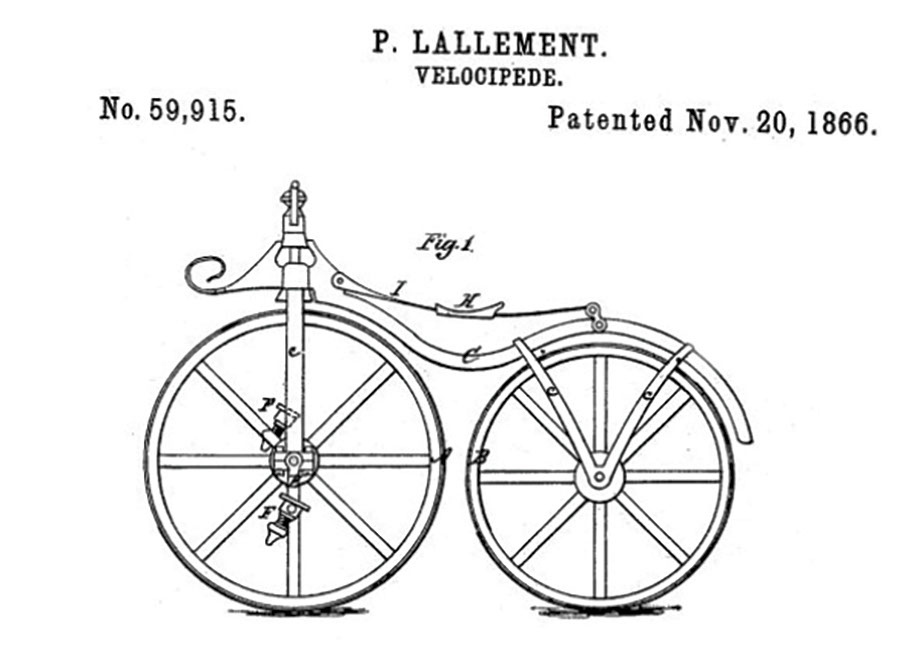
At the committee’s third meeting on March 6, it issued this statement: “Following the recent publication of certain articles that tend to establish that Pierre Michaux did not invent, but simply built and propagated, the pedal, which his son Ernest alone conceived, we unanimously endorse our President’s proposal [for a joint memorial].” Conveniently left open was the year of the claimed invention.
Despite’s Giffard’s swift and deft maneuvering, the father vs. son debate flared up again, but this time in the popular press. On March 7, the Parisian daily L’Éclair charged that the cycling world was in turmoil over the monument. It chastised the committee and Bar-le-Duc for rushing to honor Pierre Michaux while ignoring the evidence favoring Ernest.
Before writing his response, Busselot summoned Henry to Bar-le-Duc to discuss damage control. But rather than endorse Giffard’s compromise, Henry held firm to the original historical premise. Given Henry’s evident flexibility with facts, it is unclear why he was so loath to grant Ernest a role in the bicycle invention. Maybe there had been some animosity between the two brothers, or maybe Henry simply preferred a clean “like father, like son” narrative of industrial prowess as he built up his own brand.
In any case, on March 9, Busselot wrote L’Éclair: “I do indeed intend to ask our city council to help fund a monument to Pierre Michaux, but I did not make this decision without consulting the inventor’s two surviving sons [Henry and his younger brother Francisque]. I have letters from each one, independently written, affirming that their father is the sole inventor. I just saw Henry Michaux and he assured me one more time that his brother Ernest had absolutely nothing to do with the invention.”
Busselot also affirmed to L’Éclair that the date of Pierre’s invention was 1855. On March 11, the city council approved the mayor’s request for 500 francs (very roughly $5,000 in today’s currency) for the erection of a memorial to Pierre Michaux based on the original historical premise.
At this point, the memorial project had reached a crisis point. The Parisian committee had proclaimed Ernest the sole inventor, presumably in 1860-something, whereas Bar-le-Duc had vouched for Pierre as the sole inventor in 1855. Even Giffard’s compromise proposal would not be enough to paper over such a glaring discrepancy. Something had to be done to get both parties on the same page. And there was only one man who could credibly provide a new historical foundation: Henry Michaux.
Giffard no doubt warned the aspiring industrialist that the memorial project was doomed unless he provided a new invention narrative to support the compromise proposal. On March 18, Henry paid Busselot another visit to alert the mayor that the proposed monument would soon be getting a new foundation. Three days later, Henry finally wrote the editor of L’Éclair. Claiming (falsely) that he only learned of the paper’s divisive article of March 7 from his recent visit with Busselot, Henry spun an entirely new (and self-serving) invention tale.
Citing his “faithful memory,” Henry affirmed that his father and brother Ernest had indeed jointly invented the bicycle after all. But the year was 1861, not 1855. Henry even identified, apparently for the first time, the owner of the broken draisine that supposedly became the first bicycle: a hatter by the name of Brunel. Henry also revealed that he himself had witnessed the invention, quoting “verbatim” the father-and-son conversation that he claimed had led to Ernest constructing the first bicycle.
Henry’s new testimony at last gave Giffard’s compromise proposal the historical backing it needed. A jubilant colleague congratulated his editor for having correctly intuited that the bicycle was a Michaux family invention. Never mind that the committee had pronounced Ernest the inventor and Pierre the builder, whereas Henry was now saying exactly the opposite.
Although there would be a few more hiccups in the memorial campaign over the next 16 months leading to the inauguration, Henry’s new invention account essentially ended any further historical debate.
Or so I had thought, until I recently discovered that Auguste Brunel himself — Henry’s hatter — emerged days before the inauguration and gave a very different account of his encounter with the elder Michaux. Indeed, Brunel’s testimony completely undermined the monument’s raison d’être.
Why Henry suddenly invoked Brunel in his letter to L’Éclair, months into the campaign, is unclear. But it seems likely that Henry had learned that the hatter was still alive and kicking — riding the very velocipede he had bought from Michaux some three decades earlier. Henry no doubt recognized that Brunel represented another potential roadblock to the memorial and that he needed to be handled carefully. A few weeks after writing to L’Éclair, in fact, Henry revealed to Le Vélocipède Illustré that the two had had lunch together, giving Henry the opportunity to inspect Brunel’s relic.
Brunel apparently held his silence for months until Pierre Giffard published an article entitled “Père Michaux” (Father Michaux) a week before the scheduled inauguration, reiterating the claim that Brunel had been Michaux’s first bicycle customer in March of 1861. The article prompted the retired hatter, now 71 years old and living in his wife’s hometown of Jussey in southeastern France, to contact the editor of a local paper. Wrote a friend on Brunel’s behalf:
“Mr. Brunel claims [the invention of] the pedal. … I will give you many more details if you have the time to take a train here; you will see père Brunel, the original [Michaux-built] machine, and letters from the Michaux brothers.” The writer added that Brunel was not seeking personal glory, and that “he would never have said anything if the Michaux brothers had treated him correctly.”
The editor headed straight to Jussey. He described Brunel as small and spry, with lively eyes. The ex-hatter confirmed that he had indeed brought a draisine to Michaux in 1861, though he did not give a month. He stated that he had been out on the smooth alleys of the Champs-Élysées riding his vehicle when his behind became so sore that he could not stand sitting on his perch a moment longer. So he decided that it was time to implement a plan that he been entertaining for “a few days,” one that would completely transform his vehicle and soften the ride.
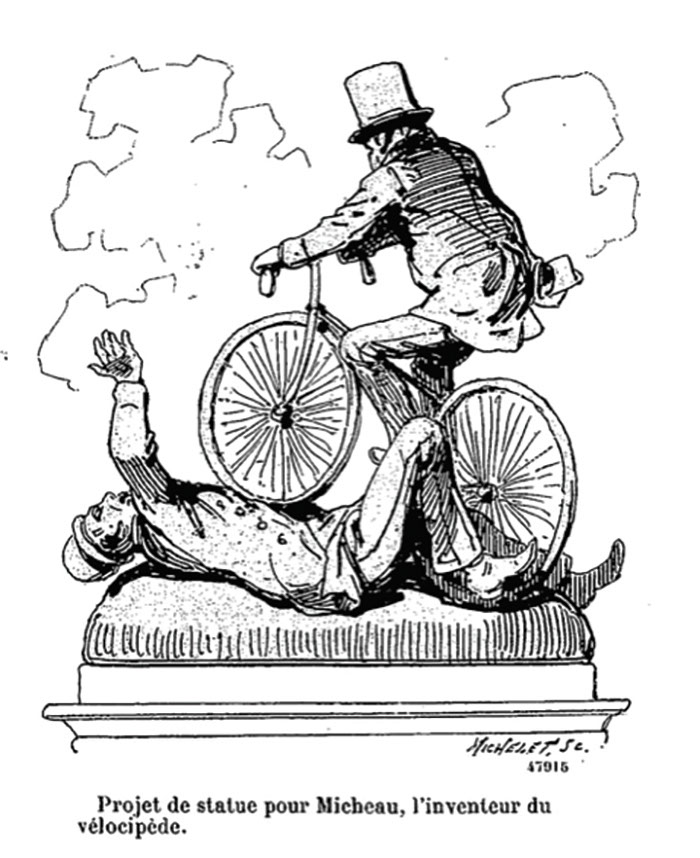
Chancing upon the nearby Michaux workshop, Brunel found just the man to do the job. He explained to the blacksmith that he wanted to create a tricycle by juxtaposing his two existing wheels on a single rear axle, while adding a front wheel. Michaux’s initial reaction, according to Brunel, was to warn his customer that a tricycle would be even more taxing on his feet. Brunel countered that he had no intention of waddling along on his tricycle; he wanted cranks and pedals attached to the front hub. He likened the mechanism to a coffee grinder, and Michaux quickly understood the concept. The blacksmith agreed to do the job for 35 francs, and eight days later Brunel collected his revamped machine.
Remarkably, the reporter affirmed, the spry Brunel was still riding that very machine regularly, covering between 12 and 15 kilometers an outing. Reportedly, Henry and Francisque had repeatedly tried to buy the vehicle, offering up to 500 francs. But Brunel adamantly refused to part with his pride and joy.
Brunel effectively dropped two bombshells with his explosive allegations: first, that he, not Michaux, had prescribed the pedal drive. And second, that he obtained a tricycle, not a bicycle. The French press, however, clearly in no mood for more controversy, simply dismissed Brunel’s testimony as “too little, too late.”
Meanwhile, Giffard acted quickly to marginalize the uncooperative hatter. On the morning of the inauguration, Giffard’s colleague at Le Vélo, Paul Manoury, published a lengthy article in Le Figaro entitled “La Genèse du Cyclisme” (the Genesis of Cycling) that effectively dished out Brunel’s comeuppance. Manoury implied that Brunel was not the owner of the broken draisine-turned-bicycle of 1861 after all (that man’s identity apparently reverted back into a state of anonymity). Rather, Manoury implied that Brunel had acquired a Michaux-built tricycle in 1863, and thus Brunel was simply “that odd little hatter who was France’s first tricyclist.”
Needless to say, Brunel’s attack had come too late in the memorial campaign to have had any effect on its outcome, and he was persona non grata at the inauguration ceremonies. His name never even came up in any of that day’s long speeches.
But what are we to make of Brunel’s newly discovered testimony, as we strive to construct a more accurate history of the bicycle invention? That comes down to two key questions: first, which party most likely proposed the pedals? And second, did Brunel leave the Michaux shop with a bicycle or a tricycle?
At first thought, it might seem more likely that the mechanically minded Michaux came up with a novel drive. But as Brunel himself pointed out, if Michaux had suddenly thought of adding pedals to a draisine, he would have been better off testing that idea on his own. Indeed, experimenting with a customer’s consignment would have created something of a “no win” situation for Michaux: if the idea failed, he would alienate his customer, and if it succeeded he would have given away a promising new design.
But it is really the second issue — bicycle or tricycle — that has the greatest historical implications. For if Brunel walked out of the Michaux shop with a three-wheeler, regardless of which party proposed the pedals, then the bicycle was evidently not invented in the Michaux shop — we would have to look beyond 1861 to identify who really sparked the original bicycle craze in Paris.
After all, treadle-driven tricycles had been known for decades and yet there is no credible evidence that anyone constructed a bicycle with a similar drive until about 1869. That is, after the original Parisian bicycle had established the surprising principle that a slender vehicle with one wheel after another could be continuously propelled, with the rider’s feet off the ground, by means of a mechanical drive.
And there is very little reason to doubt Brunel’s assertion that he left the Michaux shop with a tricycle. After all, that’s what he had in hand in 1894, and the Michaux brothers evidently accepted its authenticity. And if Brunel had been a complete fraud, he might as well have agreed with Henry that he had obtained a bicycle, in order to cast himself as the vaunted “inventor of the bicycle.”
Clearly, more research is needed before we can assess the full historical significance of Brunel’s newly discovered testimony. In particular, if the year of the Michaux/Brunel encounter was indeed 1861, then Brunel was likely responsible for an important step toward the bicycle. But if the year was actually 1863, as Manoury suggested, then Brunel may well have copied an existing machine, such as Lallement’s bicycle. In any case, the hatter may have played a pivotal role in the creation of the Michaux bicycle company.
What is already clear, however, is that the Michauxs were neither the inventors nor the original developers of the bicycle, despite what their memorial claims. And even if Lallement adapted his pedal drive from an existing tricycle, the young mechanic would still deserve the lion’s share of the credit for inventing the bicycle. That is, for building a prototype in mid-1863 that convinced himself (and others) that the bizarre arrangement was in fact practical and worthy of development.

